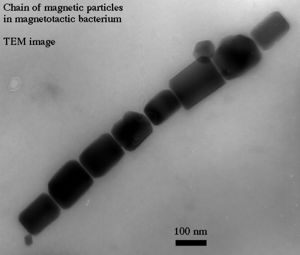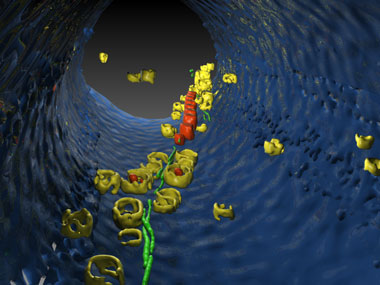Magnetotactic
A Microbial Biorealm page on the genus Magnetotactic

Classification
Higher order taxa:
Bacteria; Proteobacteria; unclassified Proteobacteria
Species:
Magnetococcus sp. MC-1, environmental samples. (source NCBI Taxonomy)
Description and Significance
Magnetotactic bacteria are the smallest organisms that use a navigational method by using the earth's geomagnetic field to develop an internal compass. They were discovered in 1975 by Richard P. Blakemore when he noticed that some of the bacteria that he observed under the microscope always moved to the same side of the slide. These bacteria are able to move in a particular direction because they make tiny, iron-containing magnetic particles. Each of these particles is a magnet with a north pole and a south pole. The bacteria arrange these tiny magnets in a line to make one long magnet. They use this magnet as a compass to align themselves to the earth's geomagnetic field.
Magnetotactic bacteria use their magnetic compass to tell them which way is down in an aquatic environment. These bacteria don't like oxygen and move from areas with high oxygen towards area with low or no oxygen. The level of oxygen decreases as one moves deeper into the water so magnetotactic bacteria live in the deeper parts of their aquatic environments, using their compass to help them.
The geomagnetic field guides the direction of motion of magnetotactic bacteria. In the Northern Hemisphere, the geomagnetic north actually oints down to an angle; the magnetotactic bacteria that are aligned to this field are also pointing down. By moving north along this field, they move deeper into the water, and into areas with less oxygen. In the Southern Hemisphere, the geomagnetic north actually points up and at an angle so magnetotactic bacteria in this half of the world are "south-seeking", which points them downward. The magnetotactic bacteria found at the equator are a mixture of north-seeking and south-seeking bacteria because the geomagnetic north doesn't point either up or down.
The practical applications of magnetotactic bacteria are of significant interest to scientists. The tiny magnets that these nacteria make are far superior to those produced by people. Scientists and engineers are trying to develop ways to use this magnetic material in places where tiny magnets are much better than big magnets.

Genome Structure
Cell Structure and Metabolism
Life cycle of Magnetotactic bacteria
Although most multicellular organisms, prokaryotes as well as animals, plants, and algae have a unicellular stage in their life cycle, an uncultured prokaryotic magnetotactic multicellular organism reproduces by binary fission. It is multicellular in all the stages of its life cycle, and during most of the life cycle the cells organize into a hollow sphere formed by a functionally coordinated and polarized single-cell layer that grows by increasing the cell size. All the cells then divide synchronously; the organism becomes elliptical, and separates into two equal spheres with a torsional movement in the equatorial plane. Unicellular bacteria similar to the cells that compose these organisms have not been found. All the organisms studied seem to belong to a single genetic population phylogenetically related to many-celled magnetotactic prokaryotic organism that proliferates in the delta sub-group of the proteobacteria. This appears to be the first report of a multicellular prokaryotic organism that proliferates by dividing into two equal multicellular organisms each similar to the parent one.
Ecology
Magnetotactic bacteria are found in the sediments of many aquatic environments. In addition to their worldwide distribution, the diversity of morphological types suggests that magnetotaxis is a feature of a number of bacterial species.
References
Clement, Sandi; "Magnetic Microbes"; Digital Learning Center for Microbial Ecology
Carolina N. Keim, Juliana L. Martins, Fernanda Abreu, Alexandre Soares Rosado, Henrique Lins de Barros, Radovan Borojevic, Ulysses Lins, Marcos Farina; "Multicellular life cycle of magnetotactic prokaryotes"; FEMS Microbiology Letters 240; 2004
Frankel, Richard B; "Magnetic Guidance of Organisms"; Annual Reviews; 1984
